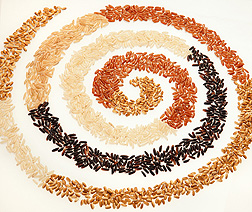This page has been archived and is being provided for reference purposes only. The page is no longer being updated, and therefore, links on the page may be invalid.
| Read the magazine story to find out more. |
|
|
|
|
Researchers Determine Beneficial Compounds in Whole-grain Rice Varieties
By Rosalie Marion BlissApril 15, 2013
U.S. Department of Agriculture (USDA) scientists and cooperators have provided knowledge about the chemical composition and potential bioavailability of nutritious compounds in a representative group of five colorful rice varieties. The findings could help breeders select for these traits from among 18,000 rice samples, called accessions, at the National Small Grains Collection in Aberdeen, Idaho.
Though often thought of as white or brown, rice is categorized into seven color classes, based on bran color, and darker varieties are thought to have higher amounts of some phytochemical compounds than lighter varieties. The studies were headed by research chemist Ming-Hsuan Chen at the Agricultural Research Service (ARS) Dale Bumpers National Rice Research Center in Stuttgart, Ark. ARS is USDA's chief intramural scientific research agency, and this research supports the USDA priority of promoting international food security.
Rice bran, an outer layer of whole grain rice, is a rich source of the phytochemical known as gamma-oryzanol, and of two forms of vitamin E—tocopherols and tocotrienols. These nutritional compounds have been linked to preventing oxidative damage in foods and to having a wide spectrum of biological activities that could be beneficial to human health.
The team used analytical methods to determine the profiles of tocopherols, tocotrienols and gamma-oryzanol in white, light brown, brown, red, and purple bran. They found a wide variation in the concentrations of the two forms of vitamin E and of gamma-oryzanol.
The team also analyzed other phytochemicals—specifically phenolics and flavonoids—in the same five color classes of bran. The study showed that the red and purple rice brans had higher phenolic and flavonoid concentrations than the lighter-colored rice brans measured. The researchers also identified one purple rice bran variety that was both high in phenolic compounds as well as vitamin E and oryzanols.
The study findings were published in the Journal of Food Science and in Food Chemistry.
Read more about this research in the April 2013 issue of Agricultural Research magazine.


